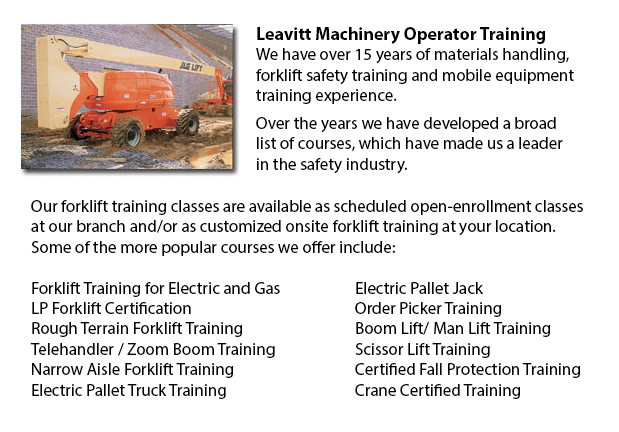
Burlington Boom Lift Safey Training - Boom lifts are a kind of aerial lifting device or elevated work platform which are usually used in industry, warehousing and construction. Boom lifts can be utilized in almost whichever surroundings because of their versatility.
The elevated work platform is used to allow access to heights which were otherwise not reachable making use of other means. There are dangers inherent when making use of a boom lift device. Workers who operate them should be trained in the correct operating methods. Preventing accidents is vital.
Boom Lift Training Programs include the safety factors involved in boom lift operation. The program is suitable for individuals who operate self-propelled elevated work platforms and self-propelled boom supported elevated work platforms. Upon successful completion of the course, participants would be issued a certificate by somebody certified to confirm the completion of a hands-on assessment.
Industry agencies, local and federal regulators, and lift manufacturers all play a role in providing information and establishing standards in order to help train operators in the safe use of elevated work platforms. The most essential ways in avoiding accidents related to the use of elevated work platforms are as follows: checking machinery, putting on safety gear and performing site assessment.
Key safety considerations when operating Boom lifts:
Operators must observe the minimum safe approach distance (MSAD) from power lines. Voltage can arc across the air to find an easy path to ground.
A telescopic boom should be retracted before lowering a work platform in order to maintain stability when the platform nears the ground.
Personnel working from the Boom lift platform must tie off in order to guarantee their safety. Safety harness and lanyard combinations should not be connected to any anchorage other than that provided by the manufacturer, never to other wires or poles. Tying off may or may not be necessary in scissor lifts, that depends on particular employer guidelines, job risks or local rules.
The maximum slope would be specified by the manufacturer. Workers should avoid working on a slope, if possible. When the slope is beyond recommended situation, the lifting device should be winched or transported over the slope. A grade could be simply measured by laying a minimum 3-feet long straight board or edge on the slope. Then a carpenter's level could be laid on the straight edge and the end raised until it is level. The per-cent slope is attained by measuring the distance to the ground (the rise) and dividing the rise by the length of the straight edge. Afterward multiply by one hundred.
-
Burlington Manlift Operator Certification
Burlington Manlift Operator Certification - Our aerial lift and scissor platform certification and training empowers those participating with a general understanding and knowledge of the safe and efficient use of "Power Operated Mobile Work Platforms... More -
Skid Steer Loader Training in Burlington
The engine powered skid-steer loader consists of a small and rigid frame, equipped along with lift arms that could connect to several industrial attachments and tools in order to execute numerous labor saving jobs. Typically, skid-steer loaders are f... More -
Burlington Manlift Training
Burlington Manlift Training - Different manlift training courses consist of the review and content of manlift devices. An important portion of the program is the practicum where students show their knowledge and practical ability to safely operate a... More -
Burlington Overhead Crane Ticket
Burlington Overhead Crane Ticket - The overhead crane is a common heavy equipment used in industrial environments. This particular equipment is known as a bridge crane and consists of parallel runways spanned by a traveling bridge. The part that lift... More -
Burlington Forklift Training Programs
Burlington Forklift Training Programs - If you are looking for work as an operator of a forklift, our regulatory-compliant forklift training programs provide exceptional instruction in various types and styles of lift trucks, lessons on pre-shift che... More -
Burlington Manlift Ticket
Burlington Manlift Ticket - The Manlifts and Elevated Platforms program provides training on the regulations, rules and proper application of safe operating measures and work practices involved in everyday activities for people who work with this equ... More -
Burlington Scissor Lift Training
Burlington Scissor Lift Training - Scissor lifts need to be operated proficiently to be able to protect the safety of the machinery and the safety of people in the workplace. Skilled operators are trained to drive the specific class of scissor lift f... More -
Burlington Fall Protection Ticket
Burlington Fall Protection Ticket - The number one reason of death within the construction trade come from fall-related incidents. There is more possibility for fall incidents depending on the kinds of work being done within your workplace. Thus, kno... More

Forklift Certification Burlington
TOLL FREE: 1-888-254-6157
Burlington, Ontario
forkliftcertificationburlington.com
Email Us
About Us


